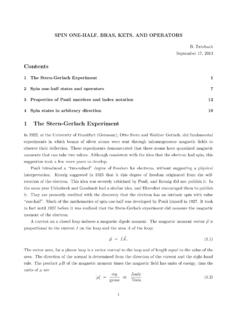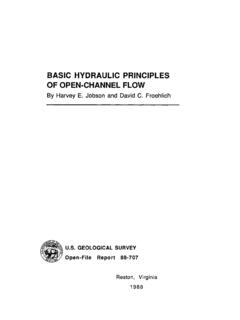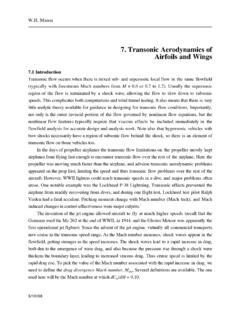Transcription of Lie Algebra Representation Theory SU(3)-Representations …
1 Lie Algebra Representation Theory SU(3)-Representations in PhysicsMA 725 North Carolina State UniversityDepartment of MathematicsChristopher KoerberDecember 3, 2013 Department of Physics, North Carolina State University, Raleigh, NC 27695, f ur Theoretische Physik II, Ruhr-Universit at Bochum, D-44870 Bochum, GermanyContents1 Physical Motivation .. Noether Theorem ..12 SU(3)- Representation From Group to Algebra .. Properties of Gell-Mann Basis .. Roots and Weights .. (2,0)- Representation .. (1,1)- Representation .. (3,0)- Representation .. 153 Flavor SU(3) in Particle From Atoms to Quarks .. The Eightfold Way .. Quarks and the Flavor SU(3) .. MA 725SU(3)Representations in Physics1 Introduction1 IntroductionThe aim of this paper is to draw the connections between elementary particle physics and representa-tion Theory of Lie algebras.
2 Generally, the symmetries of physical systems is described by Lie groups,but as it is shown in this paper, the Representation Theory of groups and algebras are directly relatedto each a general discussion ofSU(3) and the related algebrasu(3), the information about the weightspaces of different representations can be used to order physical (hadronic) particles and furthermorediscover a more fundamental scheme for the description of these paper uses and applies methods derived in the lecture [Misra, 2013], while the structure andanalysis is based on [Georgi, 1999]. Physical MotivationThe main task of a ( theoretical ) physics is the description or prediction of the behavior nature. Onestarts with an axiomatic principle of nature followed by specific assumptions for the given logic and mathematical tools one is able to obtain a possible result of the initial , if the principle of nature can be applied to a broad range of problems and the number ofassumptions is relatively small, the corresponding model of nature might be more first principle which was able to explain Einsteins relativity and classical mechanics was theso called Hamiltonian principle.
3 The equations of motion could be derived using the actionSof aphysical system for initial timetaand final timetbS[{qi(t)},{ qi(t)}]:=tb tadtL(({qi(t)},{ qi(t)},t).( )The Lagrange functionLis the sum of the kinetic energy of each particle trajectory1qi(t) minus allcorresponding potential terms. To obtain the equations of motion for each particle, one has to requirethat the variational derivative of the action in direction of each particle is stationary for the true trajectoryqc S qi( ) q=qc:= S[{qci(t) + qi(t)},{ qci(t) + qi(t)}] =0= 0.( )At the end of the first half of the 20th century Richard Feynman was able generalize this princi-ple to a even more fundamental form, the so called path integral (for a detailed introduction see[Ramond, 1997]), which was also able to incorporate quantum physics. Instead of finding the station-ary path for a particle, one takes all possible paths into account and sums up the probability of allthose paths.)
4 If one uses a relativistic action for fields, the obtained theories using the path integralformalism, are called Quantum Field Theories (QFT).To actually understand the flavor model of quarks using theSU(3)- Representation Theory , one doesnot necessarily have to understand the complete formalism of the according quantum fields, the socalled Quantum Chromo Dynamics (QCD). As it is pointed out in the third section of this paper, onejust has to recognize that the representations ofSU(3) act on the space of particles. Furthermore, toactually understand why groups play such a crucial role in physics, it is useful to review the Noether TheoremThe first theorem by Emmy Noether was published 1918 and is until now a broadly used tool intheoretical physics. Noether proofed that if the action has a continuous symmetry, a correspondingconserved quantity can be relativistic theories one introduces the Lagrange function for fields.
5 Since fields are also dependent on spacialcoordinates the Lagrange function therefore becomes an integral over the Lagrange density which is the equivalentto the classical Lagrange function of MA 725SU(3)Representations in Physics2 SU(3)- Representation TheoryTheorem :qi(t)7 q i(t, )is a continuous transformation in which does not change theactionS7 S ( ) =S, then there exists a conserved current given byJi:=( L qi(t))( q i(t, )) =0withddtJi= 0.( )As an example one could mention that invariance under time corresponds to the conservation ofenergy, invariance of coordinates to conservation of total momentum and as a further example, in-variance under spacial orientation corresponds to conservation of angular invariance under spacial orientation in three dimensions can be expressed by representations ofthe Lie groupSO(3). Therefore one understands theSO(N) groups in physics as groups of externalrotations, the rotations which change spacial (N) also plays an important role in quantum physics.
6 The representations ofSO(N) acting onquantum states are corresponding to the so called spin of there could be mentioned many applications of this group in quantum physics, the groupanalyzed in this paper is theSU(3). In physics one understands this group as a group of internalrotation. As an example, an object which is made out of internal elements can be changed byusingSU(N)-transformations to transform the internal elements into other internal elements. Thisinterpretation might get more understandable in the third section of this quantum physics, severalU(N) andSU(N) symmetries are required. The symmetry discussed inthis paper is the so called flavorSU(3) of the hadronic particles. But to understand the correspon-dence of this group to particle physics, one should analyze the properties ofSU(3) SU(3)- Representation From Group to AlgebraDefinition groupSU(3)is defined bySU(3) :={U GL(3,C) U U=1,det(U) = 1},( )whereU is the so cal led adjoint2matrix(UT) = (U ) the groupSU(3) is also a Lie group, thus it fulfills the following (3)is a compact eight parameter3group which is simply-connected through theidentity simplicity the proof of the properties of a Lie group, thatSU(3) is compact and simply-connected through the identity element, is skipped in this important for this paper is the possibility to parameterizeSU(3) with a set of eight can see this using the following idea.
7 The number of parameters to represent a matrix ofGL(3,C)is 9 2 = 18. Nine for each component and the two for the real and imaginary part. The propertyU U=1results in nine linear independent equations while det(U) = 1 fixes another the number of free parameters is given by 18 9 1 = be able to identify an Algebra corresponding to the groupSU(3) one can now use the possibilityof parameterizing the group using a set of eight parameters~ = ( 1, , 8). As a result, one is ableto find a map :SU(3) U R8through the identificationUD(SU(3))SU(3) .( )2 One should not confuse this with the adjoint- Representation of a matrix for a given commutator [ , ].3In general, the dimension ofSU(N) =N2 MA 725SU(3)Representations in Physics2 SU(3)- Representation TheoryUsing this definition of the map , one can indeed show thatSU(3) can be interpreted as a mani-fold. Since the tangent space ofSU(3) defines a linear vector space, one might be able to define acommutation relation on the tangent space which satisfy the properties of a Lie all elements are simply-connected through the identity, one can find an element of the groupU SU(3) such that this element, evaluated at the i= 0 position, is the identity elementU(~ ) ~ =0= the representationDof this group element should fulfillD(~ ) ~ =0:=D(U(~ )) ~ =0=1.
8 ( )Definition a Representation ofSU(3)defined by( ), the derivatives of the Representation ,with respect to each parameter of the group i, at the identity element are cal led j:= i jD(~ ) ~ =0.( )As it is shown later, those elements are indeed the generators of the an example, one can make the following choice for a Representation satisfying equation ( ) bydemanding thatD(~ ) =D1( 1)D2( 2) D8( 8) for the matricesD1:= cos( 1)isin( 1) 0isin( 1)cos( 1)0001 D2:= cos( 2)sin( 2) 0 sin( 2) cos( 2) 0001 ( )D4:= cos( 4)0isin( 4)0cos( 4)0isin( 4)01 D5:= cos( 5)0sin( 5)0cos( 5)0 sin( 5)01 D6:= cos( 6)000cos( 6)isin( 6)0isin( 6)1 D7:= cos( 7)000cos( 7)sin( 7)0 sin( 7)1 D3:= exp{i 3}000exp{ i 3}0001 D8:= exp{i 8}000exp{i 8}000exp{ 2i 8} 1 can easily verify the condition ( ) and ( ). Thie idea for this choice of matrices is thefollowing: take the matricesO SO(3) for rotations around each axis and include the correspondingfactors of isuch thatU U=1is generators for this Representation are given by the setga1 a 8g1= 0 1 01 0 00 0 0 g2= 0 i0i00000 g3= 1000 1 0000 ( )g4= 0 0 10 0 01 0 0 g5= 0 0 i0 00i00 g6= 0 0 00 0 10 1 0 g7= 0 000 0 i0i0 g8= 1 000 100 0 2 1 set of matrices, the so called the Gell-Mann matrices, span indeed the algebrasu(3).
9 The easiestway to proof this is to show that this set of matrices can be identified as the basis ofsl(3,C). Thereforeone can define the ordinary matrix commutator as the Lie bracket for this Algebra , knowing that thisfulfills the three conditions of an Algebra . Before doing so, one definesTa:=12ga1 a 8.( )Proposition setTafor1 a 8and the matrix commutator bracket define the algebrasu(3). MA 725SU(3)Representations in Physics2 SU(3)- Representation TheoryTo proof this, one can use that in a small area around the identity element, each matrix insu(3) canbe represented by the exponential map (see also [Scherer and Schindler, 2011])U(~ ) = exp i8 j=1 jTj .( )Proof. The set ofTageneratesSU(3)(1) AllU(~ ) satisfy det(U(~ )) = 1, sincedet(U(~ )) = det exp i8 j=1 jTj = exp Tr i8 j=1 jTj = exp{0}= 1,where Jacobis theorem det(exp{A}) = exp{Tr [A]}and the fact that allTa s are traceless are used.
10 (2) AllU(~ ) satisfyU (~ )U(~ ) =1, sinceU (~ ) = exp i8 j=1 jTj = n=01n! i8 j=1 jTj n = n=01n! i8 j=1 jT j n= n=01n! i8 j=1 jTj n= exp i8 j=1 jTj =U(~ ),where it was used that theTj s are hermitian. Furthermore one getsU(~ )U(~ ) =1sinceexp i8 j=1 jTj exp i8 j=1 jTj = exp{0}=1,using the Baker Campbell Hausdorff formula and that8 j=1 jTjobviously commutes with (3)and the matrix commutator bracket fulfill the three axioms of a Lie algebraAs previously mentioned, this can be shown by using that this set of matrices form a basis ofsl(3,C).Therefore one just has to map the matricesTaon the common basis ofsl(3,C). This map is given byH1= 2T3=E1,1 E2,2H2= 3T8 T3=E2,2 E3,3E1=T1+iT2=E1,2E2=T6+iT7=E2,3E3=T4+iT 5=E1,3F1=T1 iT2=E2,1F2=T6 iT7=E3,2F3=T4 iT5=E3, ,jdenotes the real 3 3 matrix with an one in thei jposition while the rest are map is an linear isomorphism and therefore preserves the matrix commutator bracket.







